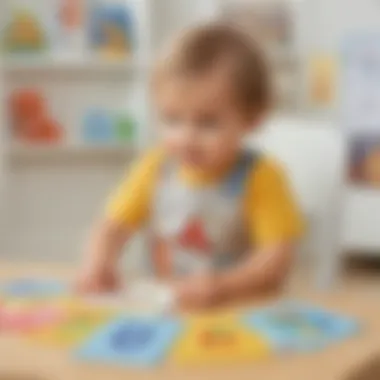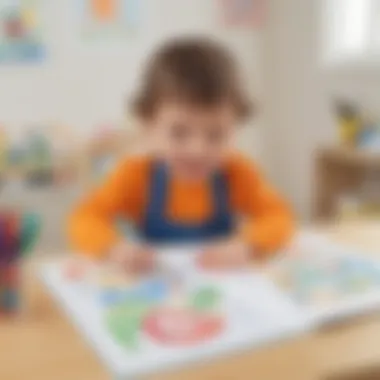Engaging Alphabet Learning Games for Toddlers


Intro
Alphabet learning is a fundamental step in a child's development, especially for two-year-olds who are just beginning to explore language. Engaging toddlers in playful activities that revolve around the alphabet can lay a strong foundation for future literacy skills. This age group is particularly curious, making it an ideal time to introduce concepts related to letters and sounds. By integrating fun and educational alphabet games into their routine, parents and caregivers can enhance their child's cognitive growth, social skills, and creative expression.
Through this article, we will examine various fun activity ideas that incorporate alphabet learning. Each idea is designed to be engaging and educational, ensuring that the learning process is enjoyable for young children. Additionally, we will touch on how these activities can help cultivate an effective learning environment. Understanding the context in which these games operate will assist in maximizing their effectiveness, ensuring that little ones not only learn the letters but also develop a love for learning.
Let’s now explore several Fun Activities Ideas that can effectively instill alphabet recognition in two-year-olds.
Prelude to Alphabet Learning
Early childhood is a critical period for language development. The introduction of alphabet learning nurtures foundational skills in literacy. This section emphasizes the significance of engaging children through tailored activities and games that facilitate learning while they play.
Children at the age of two are naturally curious. Their brains are primed to absorb new information. Integrating alphabet learning games into their routines can create a positive association with reading and writing. By making the process enjoyable, children are motivated to explore letters and sounds actively.
Understanding Early Literacy
Early literacy encompasses a child's ability to understand language in various forms. This includes speaking, listening, reading, and writing. By age two, toddlers start to recognize letters and sounds that form the basis of their future reading skills. Engaging in alphabet learning games helps solidify this understanding in a fun manner.
Literacy development at this stage can significantly impact a child's confidence and academic success later on. Playing with letters introduces toddlers to new vocabulary. It enhances their ability to communicate effectively. Encouraging these skills early also cultivates a love for books and storytelling.
The Role of Play in Learning
Play is a fundamental component of early childhood education. It allows children to explore their environment and engage in hands-on experiences. When it comes to learning the alphabet, play-based activities provide numerous benefits. They stimulate cognitive development, encourage social interaction, and promote problem-solving skills.
Through play, children can experiment with letters and sounds in a pressure-free setting. This method also caters to various learning styles. Some children may prefer visual learning, while others may thrive with auditory or kinesthetic approaches. By incorporating a mix of activities, parents and caregivers can meet the unique needs of each child.
"Learning through play leads to better retention of knowledge and skills for young children."
Moreover, active participation in games fosters emotional growth as well. Children who play together learn about sharing and cooperating. They develop interpersonal skills that are essential for future interactions.
Cognitive Development at Age Two
Cognitive development at age two is a crucial stage for young children. During this period, toddlers exhibit rapid progress in various cognitive abilities, laying the foundation for future learning. Understanding these developments can help parents and educators tailor appropriate learning experiences. This phase is characterized by exploration and a burgeoning awareness of the world around them. Engaging toddlers with alphabet learning games can stimulate their brains and encourage curiosity about language.
Milestones in Language Acquisition
Language acquisition is a significant milestone during toddler years. By age two, many children can say around 50 words. Some may even combine two words to form simple sentences. This verbal explosion marks their transition from understanding language to actively using it. It is also during this period that children begin to grasp the basic principles of communication.
Key aspects of language acquisition include:
- Vocabulary Growth: Exposure to new words is vital. Games that introduce letters and sounds facilitate vocabulary enrichment.
- Sentence Formation: Encouragement with games can help children experiment with combining words.
- Listening Skills: Active participation in alphabet activities enhances a child’s ability to listen and comprehend.
Engaging them with interactive alphabet games can enhance these skills, making them more confident in using language.
Recognizing Letters and Sounds
Another essential cognitive skill that develops at age two is letter recognition and sound association. Children begin to differentiate between letters and can identify familiar ones. This ability is crucial as it serves as a precursor to reading. Incorporating games that allow for recognizing letters can make this learning enjoyable.
- Sound Recognition: Associating letters with sounds is a foundational skill for reading. Play-based activities can facilitate this.
- Visual Recognition: Seeing letters in various formats helps solidify a child's understanding. Games can utilize different mediums, enhancing their ability to recognize letters anywhere they appear.
- Repetition and Practice: Regularly engaging toddlers with letter sounds reinforces their memory and understanding.
By fostering this recognition through games, children are better prepared for the literacy skills they will need as they grow.
"Cognitive development is not just about learning letters. It involves building connections that will last a lifetime."


Importance of Alphabet Games
Engaging in alphabet games can serve as a fundamental building block for early literacy. For 2-year-olds, the significance of these games goes beyond mere enjoyment; they enhance critical cognitive skills that are essential in a child's development. As young children begin to grasp the concepts of letters and sounds, these games provide a playful and interactive way to solidify their understanding. The engagement that comes from play fosters a natural curiosity and eagerness to learn, which are vital at this age.
Enhancing Memory and Recognition
Alphabet games improve memory and letter recognition in toddlers by creating associations between letters and sounds. Through repetitive play, children are more likely to remember the shapes and sounds of letters. For instance, matching letters with their corresponding sounds or objects can help solidify their recognition. This method has proven effective in creating neural pathways that facilitate recall when they encounter these letters again in the future. Moreover, incorporating variety in these games can keep children engaged, making the learning process more enjoyable.
"Interactive learning through play has the potential to be transformative for early literacy skills."
In this context, games that involve visual aids, such as flashcards or colorful letter tiles, can enhance a child's ability to associate letters visually. These games do not just teach the letters but create a context that helps toddlers memorize them more easily. The repetitive nature of familiar games can strengthen recall over time, ensuring that as they approach literacy, they have a solid foundation.
Promoting Cognitive Connections
Engaging in alphabet games promotes cognitive connections in young minds by linking letters to a broader understanding of language. These games encourage children to explore relationships between letters and words, paving the way for language comprehension. For example, a game that requires kids to find objects around the house that start with a certain letter helps them connect letters with real-world concepts. This hands-on approach enriches their learning experience, making it robust.
Additionally, playing these games can inspire problem-solving skills. When children are prompted to find or arrange letters, they begin to engage critically with tasks, making decisions based on the information presented. This not only bolsters their cognitive skills but also fosters an independent learning spirit.
In summary, the importance of alphabet games lies in their ability to enhance memory, recognition, and cognitive connections. Developing these skills at a young age will undoubtedly lay a solid foundation for future literacy and learning.
Types of Alphabet Learning Games
The exploration of different types of alphabet learning games is essential for tailoring an engaging learning experience for two-year-olds. Each game format offers unique advantages that can cater to various learning styles. By introducing children to a diverse array of games, one can ensure that the foundational skills of literacy are nurtured effectively. Such activities can enhance motor skills, boost cognitive development, and promote social interactions. Different games, whether digital, physical, or craft-based, allow toddlers to absorb letter recognition and phonemic awareness in enjoyable and creative ways.
Interactive Digital Games
Interactive digital games are becoming increasingly popular among young learners. Platforms designed for children often feature bright colors, playful characters, and captivating sounds that engage toddlers. These games can range from simple letter tracing apps to more complex matching games. For example, the app "Endless Alphabet" provides animations and audio pronunciations of letters and words. Such interactivity can enhance a toddler's understanding of letters and sounds while developing their hand-eye coordination.
Digital games can be very useful in limiting frustration and allowing children to learn at their own pace. Many of these games also have varying levels of complexity. This variance enables children to progress from simple tasks to more challenging ones, which helps build confidence. Moreover, parents can easily monitor progress through built-in tracking systems.
Physical Alphabet Activities
Physical alphabet activities are essential because they promote kinesthetic learning. These activities allow children to interact with their environment and learn through movement. Examples include letter scavenger hunts or alphabet yoga where each yoga pose corresponds to a letter. For instance, during a scavenger hunt, children can search for items that start with specific letters, reinforcing their letter-sound associations.
Incorporating movement is beneficial not just for learning but also for physical development. Activities like these help toddlers improve their gross motor skills. Utilizing simple items like alphabet blocks or magnetic letters can also add a tactile dimension to learning. Children can build words or even simple letter structures, reinforcing their understanding of letters and phonetics through play.
Craft-Based Learning
Craft-based learning offers another dimension to alphabet games. Through creative projects, children can explore letters with their hands. For instance, making letter collages or constructing letters out of playdough enhances both creative expression and letter recognition. Using materials like paper, markers, and stickers, children can personalize their learning experience.
These crafting activities can be integrated easily into daily routines. For example, a simple activity can involve decorating an "A" with apple stickers, tying the letter to its corresponding object. As children engage with the materials, they become more invested in what they are learning. The process of creating enriches their cognitive abilities while solidifying their understanding of the alphabet.
Engaging in various alphabet learning games can significantly enhance a child's early literacy experience.
Recommended Alphabet Games
Engaging in alphabet games is vital for the development of literacy skills in two-year-olds. At this age, children are curious and eager to explore. Recommended alphabet games help to create a foundation for future reading and writing skills. These activities are not only educational but also enjoyable. Parents and caregivers can observe their child's progress while keeping the learning environment light and fun.
The benefits of these games extend beyond simple letter recognition. They promote memory, attention, and language skills. Furthermore, they allow for interaction between children and caregivers, which is crucial at this developmental stage. Keeping learning playful can foster a deeper love for language and communication.
Letter Matching Games
Letter matching games are an effective way to reinforce the identification of letters. These games usually involve cards with letters on them. The goal is for children to match uppercase letters with their lowercase counterparts.
A few key points about letter matching games:


- Visual Recognition: They help children learn to recognize letters visually, reinforcing the shape and sound of each letter.
- Cognitive Skills: Such games enhance cognitive skills. The activity requires memory as children recall the positions of letters.
- Parental Involvement: Caregivers can participate actively, guiding their child and providing praise which boosts the child's confidence.
Overall, letter matching games build a strong understanding of the alphabet through enjoyable interaction.
Alphabet Puzzles
Alphabet puzzles combine play with learning in a very engaging way. These puzzles typically feature letters that fit into corresponding slots, presenting a playful method for children to learn the alphabet.
The importance of alphabet puzzles includes:
- Fine Motor Skills: They require small hand movements that are excellent for developing fine motor skills. Picking up and placing pieces in the puzzle helps improve dexterity.
- Problem-Solving: Puzzles engage a child’s problem-solving abilities. Children must figure out which piece goes in which spot, enhancing their critical thinking skills.
- Sound Associations: Games can also incorporate sound. As children fit a letter into the puzzle, caregivers can emphasize the sound that the letter makes.
Alphabet puzzles deliver multiple learning benefits while keeping children entertained.
Sing-Along Alphabet Songs
Music is a powerful tool in early education. Sing-along alphabet songs help reinforce letter sounds and recognition through rhythm and melody. These songs can be easily found online or learned from caregivers.
Why sing-along alphabet songs are beneficial:
- Enhancing Memory: Repetition in songs aids memory retention. Melodies can make letters and sounds easier to remember than rote memorization.
- Encouraging Participation: The engaging nature of music encourages children to join in, making them more involved in the learning process.
- Language Development: Songs inherently improve language skills. They introduce vocabulary in a fun way, facilitating word recognition as children grow.
The immersive nature of sing-along songs connects emotional engagement with learning, paving the way for lasting literacy development.
"Incorporating games into early literacy efforts enriches the learning experience, making it enjoyable and effective."
Overall, these recommended alphabet games set the stage for young children to explore letters. Parents and caregivers can explore and implement these activities to foster literacy skills effectively.
Incorporating Movement in Learning
Incorporating movement into alphabet learning is a dynamic approach that allows two-year-olds to engage with letters more actively. This method caters not only to their developing motor skills but also enhances retention of information. Movement-based activities break the monotony of traditional learning and create a more stimulating environment. Physical engagement helps toddlers connect what they learn with real-world experiences. It encourages them to explore their surroundings, fostering curiosity and interest in letters.
Action-Based Letter Games
Action-based letter games are an effective strategy to make learning enjoyable and active. These games not only introduce letters and sounds but also allow children to express themselves physically. Here are a few examples of action-based letter games:
- Letter Scavenger Hunt: Hide letters around the house or yard. As children find each letter, they can name it and say a word that starts with it.
- Letter Toss: Use soft balls with letters written on them. Children can throw the ball and say the letter they catch. It combines movement and recognition skills.
- Dance with Letters: Play a song and have children dance while you call out a letter. They need to freeze in a position that starts with that letter. This reinforces both movement and letter recognition.
These games contribute to gross motor skill advancement and cognitive connections.
Exploring the Environment for Letters
Exploring the environment is another effective way to incorporate movement in learning about letters. Toddlers can learn letters by observing their surroundings. Here are ways to make the experience enriching:
- Nature Letter Walk: Take a walk and look for letters in nature. For example, branches that form an "A" or rocks that look like an "O" can be identified and discussed.
- Store Name Hunt: While shopping, point out the letters in store signs. This practical application shows letters in use, making them more relatable.
- Letter Art: Collect items like leaves, sticks, or pebbles and arrange them to form letters. This activity not only involves movement but also creativity.
By integrating movement into learning, toddlers develop valuable skills while having fun. This approach keeps their attention and fosters a love for letters.
In summary, incorporating movement during alphabet games enhances learning by making it multisensory. It allows children to connect with letters in a context that promotes physical and cognitive development.
The Role of Parents and Caregivers
The involvement of parents and caregivers is pivotal in the journey of teaching toddlers about letters and sounds. Their engagement often directly influences the effectiveness of alphabet learning games. Children learn through imitation and interaction. When caregivers partake in these activities, they not only model behavior but also reinforce the learning process. Through their participation, children gain confidence to explore the nuances of language and literacy at an early age.
It is essential for parents to understand the unique ways toddlers retain information. Research emphasizes that young children are most receptive to learning when it is embedded in fun and enjoyable activities. This makes alphabet games an ideal medium for learning. Parents can choose games that reflect their child's interests, fostering an environment rich in literacy.


Notably, patience plays a key role in this process. Children at this age might not grasp concepts as quickly as adults expect. Caregivers who maintain a supportive attitude help mitigate frustrations that can arise during learning. The emotional climate created by caregivers greatly affects the child’s willingness to engage in learning.
"Effective learning environments nurture not only knowledge but also emotional wellbeing."
Facilitating Learning Experiences
Creating valuable learning experiences goes beyond merely providing games. Parents and caregivers should aim to create interactive moments that promote alphabet recognition. This can be achieved through storytelling , where they emphasize letters as they read books aloud. Singing songs that emphasize the alphabet can also make a significant impact. Involving children in these activities allows them to associate letters with sounds in a way that feels natural.
Moreover, caregivers should diversify the methods used for engagement. This can include:
- Using tangible resources: Items like letter blocks or magnetic letters can make learning tactile and visually stimulating.
- Utilizing everyday scenarios: Pointing out letters on signs or packaging while on walks makes letters a part of the child's world.
- Encouraging questions: Allowing children to ask about letters can turn mundane moments into rich learning experiences.
By incorporating varied activities, caregivers can maintain the child's interest and cater learning to each child's unique pace and style.
Creating a Literacy-Enriched Environment
A literacy-rich environment serves as a strong foundation for alphabet learning. This does not have to involve expensive materials or complex setups. Simple changes around the home can lead to impactful learning opportunities. For instance, labeling furniture or common items with their respective letters can help toddlers make connections between symbols and sounds.
Having books accessible within the child's reach fosters a love for reading. It invites exploration. Parents should regularly read together, using opportunities to revisit the alphabet. Additionally, displaying art pieces made by the child that feature letters can reinforce learning in a celebratory manner.
In summary, when parents and caregivers actively engage in alphabet learning, they cultivate a supportive and stimulating environment. Their role is not merely to supervise but to participate. This makes learning enjoyable, thus enhancing the early literacy development crucial at this age.
Monitoring Progress
Monitoring progress in the context of alphabet learning games for two-year-olds is crucial. Assessing how well children are absorbing letters and sounds can provide both insights and encouragement to parents and caregivers. It also establishes a foundation for future literacy skills.
Assessing Literacy Skills
Assessing literacy skills at this age can take many forms. Observations during play can be insightful. For instance, watch how a child interacts with letter-based games. Are they able to identify letters when prompted? Can they match them to corresponding sounds? Keeping a record of these observations helps track improvements. This process does not have to be formal. Simple note-taking in a notebook can suffice.
An effective strategy involves using a variety of tools. Simple letter flashcards can help. Seeing letters repeatedly can aid recognition. Additionally, engaging in conversations about letters during daily activities can reinforce learning. For example, pointing out the letter 'B' when reading a book or singing songs can enhance their understanding. By integrating literacy assessment naturally into daily routines, literacy skills can be evaluated without pressure.
Encouraging Positive Reinforcement
Encouraging positive reinforcement is important when monitoring progress. Recognizing achievements, no matter how small, boosts a child's confidence. When a child successfully identifies a letter, immediate praise can reinforce their effort. This is not just about outcomes; it is about nurturing an environment where learning feels rewarding.
Incorporating rewards can also be effective. Small incentives, like a sticker or extra playtime, can encourage continued participation in alphabet learning games.
Here are some ideas for positive reinforcement:
- Verbal Praise: Simple words like "Great job!" or "You did it!" can encourage further exploration.
- Celebrating Milestones: Acknowledging when the child can string letters together successfully is vital.
- Creating a Visual Chart: Tracking daily or weekly achievements on a poster can visually demonstrate progress.
"Positive reinforcement is essential to cultivate a love for letters and learning in young children."
By regularly monitoring progress through assessment and encouragement, parents and caregivers can support their child's literacy journey. Engaging with children in meaningful ways not only enhances their skills but also strengthens the bond of learning together.
End
The conclusion of this article emphasizes the significance of incorporating alphabet learning games for two-year-olds as a powerful tool in early education. Engaging children in these games fosters an environment where learning becomes enjoyable and effective. The key elements highlighted include not only the enhancement of literacy skills but also the development of cognitive abilities. Such games serve as a medium through which toddlers can explore letters and sounds in interactive ways that resonate with their natural curiosity.
Summarizing the Importance of Learning Games
Learning games are not mere activities. They play a critical role in shaping a child’s educational journey. These games stimulate brain development, aid memory retention, and improve language acquisition. For example, when a child matches letters with corresponding images, they reinforce their understanding of both letters and their sounds. This reinforces alphabet recognition and creates a strong foundation for future reading skills.
Moreover, these games foster social skills when played with peers or caregivers. Toddlers learn turn-taking, share playtime, and communicate ideas and emotions. Thus, interactive alphabet games support both literacy and social development at a tender age.
Future Outlook on Early Education
Looking ahead, the integration of technology and innovative teaching methods will continue to evolve early education. As we have seen, digital platforms now provide engaging ways for young learners to interact with letters and sounds. The availability of interactive apps complements traditional learning methods, ensuring flexibility and diverse approaches.
However, regardless of the medium, the core principle remains unchanged: learning must be engaging and enjoyable. Parents and educators must be mindful to strike a balance between screen time and hands-on activities. The ultimate objective is to cultivate a lifelong love of learning in young children. By focusing on play-based learning, we pave the way for an enriched educational experience that prepares them for future challenges.



